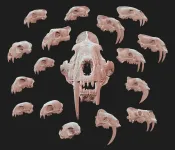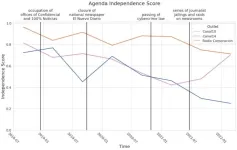(Press-News.org) Many people are concerned about residues of chemicals, contaminants or microplastics in their food. However, it is less well known that many foods also contain toxins of completely natural origin. These are often chemical compounds that plants use to ward off predators such as insects or microorganisms. These substances are found in beans and potatoes, for example, and can pose potential health risks. However, according to a recent representative survey by the German Federal Institute for Risk Assessment (BfR), only just under half of the respondents (47 per cent) were even aware of plant toxic substances. The BfR Consumer Monitor Special on naturally occurring plant toxins also revealed that this risk worries 27 per cent. In contrast, residues in food (e.g. from plant protection products) and contaminants, i.e. substances that are not intentionally added to food (e.g. heavy metals), cause concern for 63 and 62 per cent of respondents respectively. "The survey results make it clear that risks of natural origin tend to be underestimated, while risks of synthetic origin tend to be overestimated," says BfR President Professor Andreas Hensel."
Link to the consumer monitor
https://www.bfr.bund.de/cm/364/bfr-consumer-monitor-2024-special-naturally-occurring-plant-based-toxins.pdf
Raw plant-based foods are consumed frequently by 34 per cent, occasionally or rarely by 45 per cent and very rarely or not at all by 19 per cent.
Which foods with naturally occurring plant toxins do you already know? If this question is asked openly and without pre-selection, potatoes are named first (15 per cent), followed by tomatoes, raw beans (nine per cent each) and mushrooms (five per cent).
Naturally occurring toxic substances worry 27 per cent in the survey. More than half of the respondents (53 per cent) feel poorly informed about plant toxins in food, while only eight per cent feel well informed.
At 63 per cent and 62 per cent respectively, significantly more consumers are concerned about residues or contaminants.
Residues are residual amounts of substances that are used in the production of food. For example, residues can remain in fruit, vegetables or cereals even if plant protection products are used correctly.
Contaminants, on the other hand, are undesirable substances that unintentionally end up in food. They can occur naturally in the environment, arise during the processing of raw materials into food or be released into the environment as a result of human activities. Contaminants are undesirable because they can be harmful to health under certain circumstances.
The study also shed light on the related topic of "mouldy food". Here, too, there is a clear need for education. Even small amounts of mould toxins can be harmful to the health of humans and animals. Mouldy jam, for example, should therefore always be disposed of completely. Nevertheless, 25 per cent of respondents stated that they only remove the mouldy part. Even in the case of mouldy berries, affected and surrounding fruit should no longer be eaten. Only 60 per cent adhere to this rule.
About the BfR
The German Federal Institute for Risk Assessment (BfR) is a scientifically independent institution within the portfolio of the Federal Ministry of Food and Agriculture (BMEL) in Germany. The BfR advises the Federal Government and the States (‘Laender’) on questions of food, chemicals and product safety. The BfR conducts independent research on topics that are closely linked to its assessment tasks.
This text version is a translation of the original German text which is the only legally binding version.
END
Natural toxins in food: Many people are not aware of the health risks
German Federal Institute for Risk Assessment publishes special edition of the BfR Consumer Monitor
2024-05-16
ELSE PRESS RELEASES FROM THIS DATE:
Archaeology: Egyptian pyramids built along long-lost Ahramat branch of the Nile
2024-05-16
31 pyramids in Egypt, including the Giza pyramid complex, may originally have been built along a 64-km-long branch of the river Nile which has long since been buried beneath farmland and desert. The findings, reported in a paper in Communications Earth & Environment, could explain why these pyramids are concentrated in what is now a narrow, inhospitable desert strip.
The Egyptian pyramid fields between Giza and Lisht, built over a nearly 1,000-year period starting approximately 4,700 years ago, now sit on the edge of the inhospitable Western Desert, part of the Sahara. ...
Effectiveness of a web-based cognitive behavioral self-help intervention for binge eating disorder
2024-05-16
About The Study: In this randomized clinical trial of a web-based self-help intervention for patients with binge eating disorder, the findings confirmed its effectiveness in reducing binge eating episodes and improving various mental health outcomes, highlighting a scalable solution to bridge the treatment gap for this condition.
Corresponding Author: To contact the corresponding author, Luise Pruessner, M.S., email luise.pruessner@psychologie.uni-heidelberg.de.
To access the embargoed study: Visit our For The Media website at this link ...
Physician and AI chatbot responses to cancer questions from social media
2024-05-16
About The Study: The findings of this study suggest that chatbots can generate quality, empathetic, and readable responses to patient questions comparable to physician responses sourced from an online forum. Further research is required to assess the scope, process integration, and patient and physician outcomes of chatbot-facilitated interactions.
Corresponding Author: To contact the corresponding author, Srinivas Raman, M.D., M.A.Sc., email srinivas.raman@rmp.uhn.ca.
To access the embargoed study: Visit ...
How did sabre-toothed tigers acquire their long upper canine teeth?
2024-05-16
In a groundbreaking study, an international team led by scientists from the University of Liège has investigated the evolutionary patterns behind the development of sabre teeth, with some unexpected results along the way. A study that enriches our understanding of the Earth's past, but also documents the mechanisms leading to evolutionary convergence.
Sabre teeth, those iconic elongated upper canine teeth, have long fascinated both scientists and the general public, notably because they have appeared several times in the fossil record, including two particularly well-known lineages of sabre-toothed tigers: the felids (the family of ...
End-of-life systemic treatment for patients with advanced cancers does not improve survival
2024-05-16
Patients with very advanced solid tumors saw no significant improvement in overall survival after receiving systemic therapy, according to a study published today in JAMA Oncology by researchers at The University of Texas MD Anderson Cancer Center and Yale Cancer Center.
The findings provide further evidence to help oncologists counsel patients that additional cancer-directed therapy is not likely to benefit them, allowing them to focus instead on palliative and supportive care options that have been demonstrated ...
To optimize guide-dog robots, first listen to the visually impaired
2024-05-16
May 16, 2024
To Optimize Guide-Dog Robots, First Listen to the Visually Impaired
Award-winning research led by UMass Amherst shows to be successful, Guide-dog users and trainers need to provide insight into features that make robotic helpers useful in the real world
AMHERST, Mass. — What features does a robotic guide dog need? Ask the blind, say the authors of an award-winning paper. Led by researchers at the University of Massachusetts Amherst, a study identifying how to develop robot guide dogs with insights from guide dog users and trainers won a Best Paper Award at ...
Imaging fibrous structure abnormalities of the white of the eye in myopathic patients
2024-05-16
Researchers provide an innovative approach to understanding ocular pathologies by visualizing the fiber structure of the sclera, the outermost eye layer
Tokyo, Japan – Eye diseases are extremely prevalent worldwide, with recent estimates suggesting that one-third of the global population suffers from some type of vision impairment. Given the high complexity of the human eye, the precise origin and nature of many eye diseases remain unclear, leaving affected people with limited diagnostic and treatment options.
Now, in a study made available online on March 7, 2024 and published in Volume 142, Number 4 of JAMA Ophthalmology on ...
Loneliness and mental health problems are interconnected
2024-05-16
“We have found a correlation between loneliness and several mental health problems,” says Associate Professor Rubén Rodríguez-Cano at the Norwegian University of Science and Technology (NTNU’s) Department of Psychology.
In a new study, researchers are looking at whether lonely people are more prone to problems such as depression and psychosis. Based on medication use, the correlation is clear.
“The risk of a lonely person also struggling with mental health problems is greater than for people who ...
Dr. Daniel Geynisman named new Editor-in-Chief for JNCCN—Journal of the National Comprehensive Cancer Network
2024-05-16
PLYMOUTH MEETING, PA [May 16, 2024] — Daniel M. Geynisman, MD, is being announced as the new Editor-in-Chief for JNCCN—Journal of the National Comprehensive Cancer Network. Dr. Geynisman has a long history of working with NCCN in a variety of roles and served as medical oncology section editor for Urologic Oncology: Seminars and Original Investigations since 2018 and authored more than 130 peer-reviewed publications. He is an Associate Professor in the Department of Hematology/Medical Oncology and Chief of the Division of Genitourinary Medical Oncology at Fox Chase Cancer Center.
“We are thrilled to welcome Dr. Geynisman into this ...
A new and better way to detect media censorship
2024-05-16
Worldwide news media are facing increasing pressure from autocrats to report favourably about their leaders and party politics. Political scientists launch a new computational method that can detect such media censorship by states while it is happening. This method provides valuable insights for communicating regime-driven media capture to the public. It is now described in detail in the scientific journal ‘Democratization’.
One of the first steps of would-be autocrats is to control the ...
LAST 30 PRESS RELEASES:
Pure bred: New stem cell medium only has canine components
Largest study of its kind highlights benefits – and risks – of plant-based diets in children
Synergistic effects of single-crystal HfB2 nanorods: Simultaneous enhancement of mechanical properties and ablation resistance
Mysterious X-ray variability of the strongly magnetized neutron star NGC 7793 P13
The key to increasing patients’ advance care medical planning may be automatic patient outreach
Palaeontology: Ancient tooth suggests ocean predator could hunt in rivers
Polar bears may be adapting to survive warmer climates, says study
Canadian wildfire smoke worsened pediatric asthma in US Northeast: UVM study
New UBCO research challenges traditional teen suicide prevention models
Diversity language in US medical research agency grants declined 25% since 2024
Concern over growing use of AI chatbots to stave off loneliness
Biomedical authors often call a reference “recent” — even when it is decades old, analysis shows
The Lancet: New single dose oral treatment for gonorrhoea effectively combats drug-resistant infections, trial finds
Proton therapy shows survival benefit in Phase III trial for patients with head and neck cancers
Blood test reveals prognosis after cardiac arrest
UBCO study finds microdosing can temporarily improve mood, creativity
An ECOG-ACRIN imaging study solves a long-standing gap in metastatic breast cancer research and care: accurately measuring treatment response in patients with bone metastases
Cleveland Clinic presents final results of phase 1 clinical trial of preventive breast cancer vaccine study
Nationally renowned anesthesiology physician-scientist and clinical operations leader David Mintz, MD, PhD, named Chair of the Department of Anesthesiology at the UM School of Medicine
Clean water access improves child health in Mozambique, study shows
Study implicates enzyme in neurodegenerative conditions
Tufts professor named Fellow of the National Academy of Inventors
Tiny new device could enable giant future quantum computers
Tracing a path through photosynthesis to food security
First patient in Arizona treated with new immune-cell therapy at HonorHealth Research Institute
Studies investigate how AI can aid clinicians in analyzing medical images
Researchers pitch strategies to identify potential fraudulent participants in online qualitative research
Sweeping study shows similar genetic factors underlie multiple psychiatric disorders
How extreme weather events affect agricultural trade between US states
Smallholder farms maintain strong pollinator diversity – even when far from forests
[Press-News.org] Natural toxins in food: Many people are not aware of the health risksGerman Federal Institute for Risk Assessment publishes special edition of the BfR Consumer Monitor






